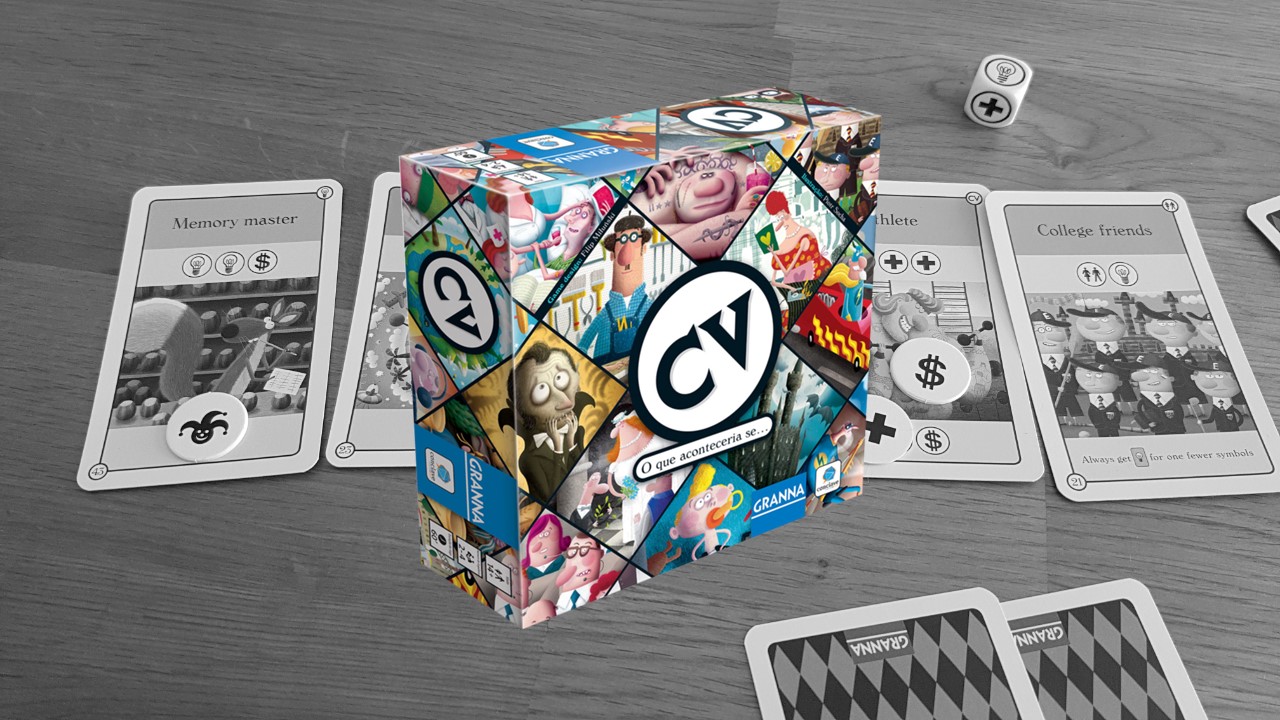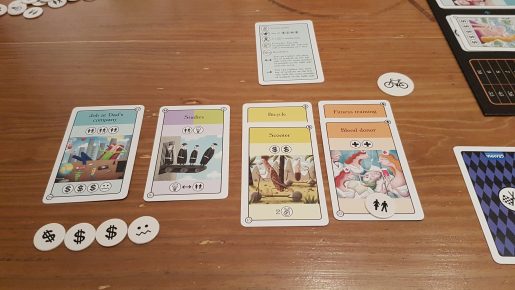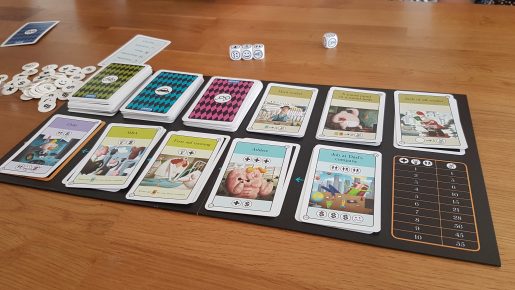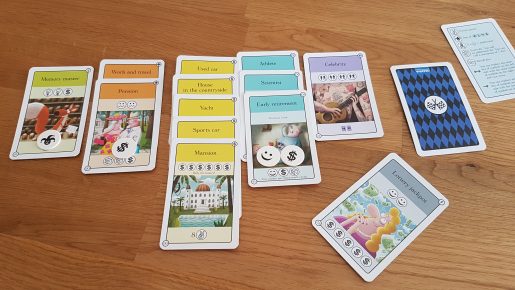CV is a card and dice game, from 2013, which instead of just being work focused (curriculum vitae) is more about forming a life resume for your character. Designed by Filip Miłuński, players will be pushing their luck against the dice, in a modern interpretation of the Game of Life. Taking around 45 – 60 minutes to play, with 2 – 4 players, the characters could become professors, have twins, purchase everything from a bicycle to a mansion, go on a streak of bad luck and more. However, is CV worth applying yourself? Let’s find out!
Over the course of the game players will build up a CV, piles of purchased cards, that detail things about their characters life. The game is broken down into 5 stages: childhood, early adulthood, middle age, old age and… scoring. At the offset of the game players are dealt three childhood cards and a life goal card, with communal life goals revealed. Childhood is different from the next three stages as it involves card drafting. Choose one of the cards dealt to you to keep and passing the rest on. Players then choose one from the cards passed to them, and so on until everyone has three chosen cards. Whomever took the bicycle gets to start the next round off, with play then going clockwise around the table.
Throughout the early adulthood, middle age and old age phases the gameplay is the same, but the pile cards are drawn from changes. Five cards are initially flipped from the early adulthood deck to create an available track. On a turn a player rolls, by default, 4 dice, with two available rerolls. Using the different symbols players can then purchase up to 2 cards from the track. While CV might sound job oriented there is plenty more to the lives of the fictional characters people will be playing as. Health, knowledge, relationships, possessions and even life events are all part of what tells the story. Each offers a kind of benefit; from free symbols to use in future rounds, gifting players a token of that symbol, to the ability to roll additional dice.
Each type of card is kept separate, stacking whenever a new card of a type already owned is purchased. For knowledge, relationships and health these can be stacked above or below previous cards. This is important as when cards are hidden their benefits are lost. Possessions and jobs are different and must always be placed on top, showing the progression of a career and materialistic journey. This makes taking a job an interesting decision as you’ll lose the perks of the old job.
To help players out are event cards, in the form of purchasable ones and the childhood cards drafted at the beginning. These are one time use cards that can be discarded to provide the indicated symbols, enabling the player to purchase a card. These range from extra relationship symbols to a bumper load of cash, potentially flipping a turn where you’d be able to buy nothing into a decent one.
There are two special symbols on the dice that rarely appear as card costs, good and bad luck symbols – represented by happy and worried faces respectively. These only come into effect when a set of three are rolled together, for better or worse. Good luck enables the player to take any card from the track, regardless of its cost. At the other end of the spectrum, bad luck will cause something from your life to go wrong, thus you have to discard a card from your tableau.
Before each players turn the track is refilled from the lowest age deck, with the left most card being discarded from the track at the end of each round. Whenever one of the first two decks run out players count the cards they have purchased: anyone with under half the number of another player gets to take a card for free from the track. This is a minute but sometimes effective catch up mechanic, depending on the available cards. After refilling from the old age deck, if there are less cards left in the deck than players the game ends.
Scoring is a relatively easy affair, helped by the handy included score pad. Based on the table on the board, players earn points for the number of knowledge, health and relationship cards they have in their tableau. Next up, players sum up the points on their purchased possession cards. Revealing their personal life goal cards, players determine how many times they have completed the card combination on the card to calculate the points earnt. Finally, whomever has best achieved each public life goal separately scores them. The winner is the person with the most total points, with ties broken by the player with the least purchased cards.
Production wise the effort has been poured into the main attraction, the cards, with the dice being the next focus. Each card has unique art, related to the possession, job or whatever the card type is. Helpfully, types of cards are easily identifiable via colour, though there are also small symbols at the top of the cards. The dice are nice to roll, though other than the symbols do little to stand out. Alas, the cardboard used for the tokens is on the weak, flimsy side reducing the overall premium feel of the title.
The game board is not needed for play, merely adding spaces to place cards and featuring the scoring table that is printed in the rules. Nevertheless, it is a great inclusion as it allows setup and deck organisation to be a breeze. Singling out the board it is the only component that limits a major reduction in game box size, something CV goes over the top in – in almost criminal amounts. Remove the insert and the components almost shamefully fit into the lower third of the box. With shelf space at a premium for many gamers it makes it harder to want to keep CV due to the amount of emptiness the box has.
Praying to the dice gods for help may make you feel better but there are ways CV tries to mitigate some aspects of luck. The ability to purchase cards that offer usable symbols helps players build up slowly but surely. It’s even possible to guarantee yourself 3 good luck symbols each turn, allowing you to claim any card, with the right purchases. Bad luck can creep into play, both dice wise and symbol wise, but have the right cards and you can advert a card losing crisis. The game also doesn’t drag on too long, be it at full or lowest player count. Therefore, it is easier to “suffer” batches of unlucky rolls.
CV takes the ideas of forming a life for a character, with events and cards specifically designed to be points throughout their life, and turns it into a dice rolling experience. Much like real life, it seems people will need a slice of luck to get a big break, but there are ways to chip slowly away and gain victory. Despite the dice often going against me CV offers an entertaining experience, seeing the stories come to life. Just as a character gets bad luck, so must leave their marriage, they get the symbols needed to get a PhD on the same turn. These incredible cards create small stories that thread together, adding background and believability to the characters’ lives. It might not be for everyone due to the luck aspects that are still present within any dice roller. However, for those whom like titles to grow stories whilst having objectives CV could be for you!
[Editor’s note: CV was provided to us by Coiledspring Games for the review.]




